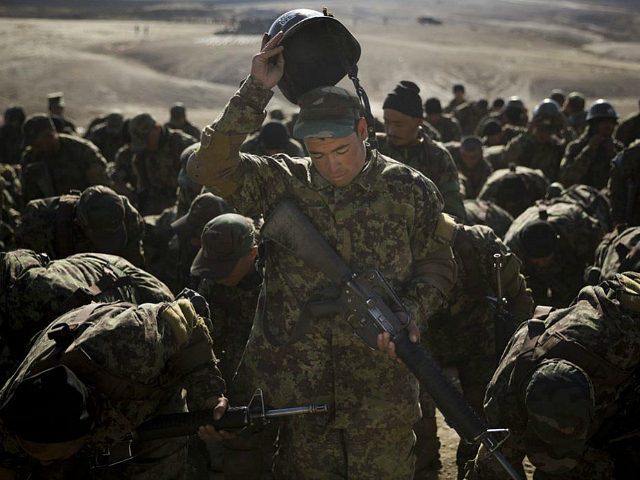A congressionally-appointed watchdog agency warns that dozens of Afghan security troops, deemed “high-risk” after going absent without leave (AWOL) while training on U.S. soil since 2005, remain unaccounted for and “may pose a security risk.”
In total, 152 Afghan security troops have gone missing, nearly half of the total 320 foreign military trainees that went AWOL while training inside the United States since 2005, reports the U.S. Special Inspector General for Afghanistan Reconstruction (SIGAR) in an audit published Friday.
“Of the 152 AWOL Afghan trainees, 83 either fled the United States after going AWOL or remain unaccounted for,” explains SIGAR in a report on Friday. “We also found that these instances of AWOL may have negative consequences, both for Afghanistan and the United States. For example, we found that the increasing instances of AWOL since 2015 may have had a negative impact on operational readiness of Afghan National Defense and Security Forces (ANDSF) units and the morale of fellow trainees and home units, and posed security risks to the United States.”
The inspector general attributes the problem, in part, to “the limited vetting of Afghan trainees, and the restrictions of the investigatory and asylum processes.”
The Pentagon believes the AWOL rate “is likely to either remain steady or increase” due to “the deteriorating security situation in Afghanistan and the fact that Afghan trainees who violate the terms of their visas suffer virtually no consequences for going AWOL (except for the possible return to Afghanistan),” reports the watchdog.
U.S officials have awarded “legal status” to some of the ANDSF troops after they went missing.
Citing data from the Pentagon’s Defense Security Cooperation Agency (DSCA), SIGAR reveals that “law enforcement arrested, or removed only 27 of the 152 (approximately 18 percent) AWOL Afghan trainees since 2005. The remainder successfully fled the United States after going AWOL, obtained legal status, remain unaccounted for, or are no longer AWOL.”
The ANDSF includes police and military units.
SIGAR’s analysis covers members of the Afghan security forces who went AWOL between August 2005 and March 2017.
The watchdog agency reveals that most of the AWOL Afghan trainees disappeared under the previous administration — in 2009, 2015, and 2016 — noting that the “years that coincided with higher reported levels of violence in Afghanistan.”
SIGAR notes that the Immigration and Customs Enforcement (ICE) agency, a component of the U.S. Department of Homeland Security (DHS), considers the AWOL Afghan trainees to be “high risk.”
The U.S. watchdog agency reports:
Although we are not aware of any acts of terrorism or similarly serious acts involving Afghan trainees who have gone AWOL, such cases are considered by the CTCEU [ICE’s Counterterrorism and Criminal Exploitation Unit] to be high risk because they involve militarily trained individuals of a fighting age who have demonstrated a “flight risk,” and have little or no risk of arrest and detention for absconding from training.
The AWOL rate among Afghan trainees reached a historic level last year.
“In 2016, the percentage of Afghan trainees who went AWOL from U.S.-based training doubled from the historical average of 6-7 percent to 13 percent,” reports SIGAR.
Although a small percentage of Afghan soldiers who train inside the United States disappear, the rate is much higher when compared to trainees from other countries.
“The 152 Afghan trainees who went AWOL in the United States represents approximately 6 percent of all Afghans who received training in the United States,” explains the inspector general. “Conversely, only 0.07 percent of trainees from other countries went AWOL in the United States.”
SIGAR revealed that the Afghans are training in the United States at the expense of the American taxpayer, acknowledging that most (nearly $70 billion) of the estimated $120 billion appropriated for reconstruction efforts in Afghanistan since 2001 have been devoted to developing the ANDSF.
“One part of this effort has been the attempt to train certain ANDSF personnel in the United States, based on the determination that comparable training could not be provided elsewhere, such as Afghanistan,” writes John Sopko, the SIGAR chief. “However, since 2005, far more Afghan trainees have gone AWOL in the United States than trainees from any other nation, and the likelihood of Afghan trainees to go AWOL has increased in recent years as the security situation in Afghanistan has continued to deteriorate.”

COMMENTS
Please let us know if you're having issues with commenting.